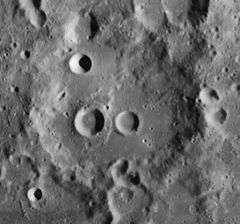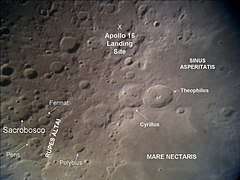Sacrobosco (crater)
Sacrobosco is an irregular lunar impact crater that is located in the rugged southern highlands to the west of the Rupes Altai escarpment. It is a readily identified feature due to the three circular craters that lie on its floor. The rim of Sacrobosco is heavily worn and eroded, especially in the northeast. The floor is relatively flat in the south, except where overlain by Sacrobosco A and B, but is somewhat irregular in the northeast.
 Lunar Orbiter 4 image | |
| Coordinates | 23.7°S 16.7°E |
|---|---|
| Diameter | 98 km |
| Depth | 2.8 km |
| Colongitude | 344° at sunrise |
| Eponym | Johannes de Sacrobosco |

Location of Sacrobosco
To the northwest of Sacrobosco is the double crater Abenezra and Azophi. To the east-northeast is Fermat, and to the south-southwest lies Pontanus.
Satellite craters
By convention these features are identified on Lunar maps by placing the letter on the side of the crater midpoint that is closest to Sacrobosco.
| Sacrobosco | Latitude | Longitude | Diameter |
|---|---|---|---|
| A | 24.0° S | 16.2° E | 17 km |
| B | 23.9° S | 16.9° E | 14 km |
| C | 23.0° S | 15.8° E | 13 km |
| D | 21.6° S | 17.7° E | 24 km |
| E | 26.1° S | 17.7° E | 13 km |
| F | 21.1° S | 16.7° E | 19 km |
| G | 20.7° S | 16.2° E | 20 km |
| H | 23.7° S | 18.7° E | 13 km |
| J | 23.6° S | 14.6° E | 5 km |
| K | 22.9° S | 14.7° E | 6 km |
| L | 25.6° S | 15.1° E | 9 km |
| M | 25.3° S | 16.3° E | 8 km |
| N | 27.0° S | 16.5° E | 6 km |
| O | 21.1° S | 16.0° E | 6 km |
| P | 20.6° S | 17.3° E | 5 km |
| Q | 21.6° S | 17.5° E | 42 km |
| R | 22.3° S | 15.7° E | 21 km |
| S | 26.5° S | 18.0° E | 19 km |
| T | 24.9° S | 16.8° E | 12 km |
| U | 24.0° S | 14.3° E | 5 km |
| V | 24.5° S | 16.1° E | 4 km |
| W | 24.3° S | 17.3° E | 2 km |
| X | 26.5° S | 16.3° E | 23 km |
gollark: Neuron signalling runs at a maximum of 100Hz or so so most stuff has to be done in parallel.
gollark: Sometimes we execute serial tasks.
gollark: That would just be a brain but stupider.
gollark: Apiaristic power generation is an entirely orthogonal idea though. I don't think you know how this works.
gollark: Internally we haven't seen the need since we just have one arbitrarily fast core.
References
- Andersson, L. E.; Whitaker, E. A. (1982). NASA Catalogue of Lunar Nomenclature. NASA RP-1097.
- Blue, Jennifer (July 25, 2007). "Gazetteer of Planetary Nomenclature". USGS. Retrieved 2007-08-05.
- Bussey, B.; Spudis, P. (2004). The Clementine Atlas of the Moon. New York: Cambridge University Press. ISBN 978-0-521-81528-4.
- Cocks, Elijah E.; Cocks, Josiah C. (1995). Who's Who on the Moon: A Biographical Dictionary of Lunar Nomenclature. Tudor Publishers. ISBN 978-0-936389-27-1.
- McDowell, Jonathan (July 15, 2007). "Lunar Nomenclature". Jonathan's Space Report. Retrieved 2007-10-24.
- Menzel, D. H.; Minnaert, M.; Levin, B.; Dollfus, A.; Bell, B. (1971). "Report on Lunar Nomenclature by the Working Group of Commission 17 of the IAU". Space Science Reviews. 12 (2): 136–186. Bibcode:1971SSRv...12..136M. doi:10.1007/BF00171763.
- Moore, Patrick (2001). On the Moon. Sterling Publishing Co. ISBN 978-0-304-35469-6.
- Price, Fred W. (1988). The Moon Observer's Handbook. Cambridge University Press. ISBN 978-0-521-33500-3.
- Rükl, Antonín (1990). Atlas of the Moon. Kalmbach Books. ISBN 978-0-913135-17-4.
- Webb, Rev. T. W. (1962). Celestial Objects for Common Telescopes (6th revised ed.). Dover. ISBN 978-0-486-20917-3.
- Whitaker, Ewen A. (1999). Mapping and Naming the Moon. Cambridge University Press. ISBN 978-0-521-62248-6.
- Wlasuk, Peter T. (2000). Observing the Moon. Springer. ISBN 978-1-85233-193-1.
This article is issued from Wikipedia. The text is licensed under Creative Commons - Attribution - Sharealike. Additional terms may apply for the media files.